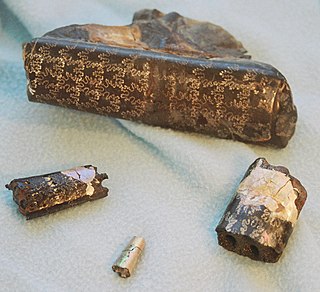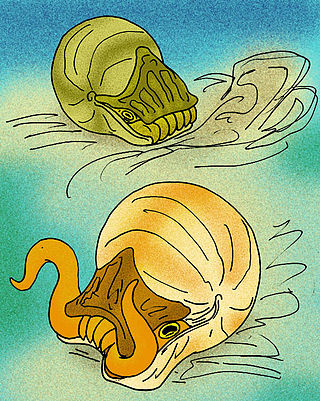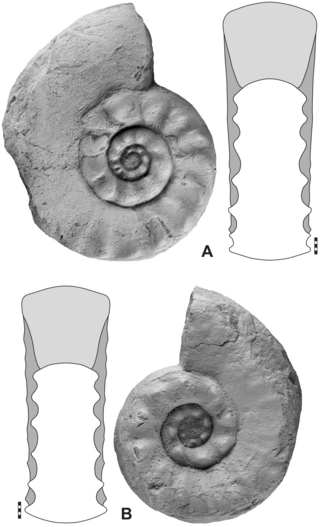
Ammonoids are extinct spiral shelled cephalopods comprising the subclass Ammonoidea. They are more closely related to living coleoids than they are to shelled nautiloids. The earliest ammonoids appeared during the Devonian, with the last species vanishing during or soon after the Cretaceous–Paleogene extinction event. They are often called ammonites, which is most frequently used for members of the order Ammonitida, the only living group of ammonioids from the Jurassic up until their extinction.

Goniatids, informally goniatites, are ammonoid cephalopods that form the order Goniatitida, derived from the more primitive Agoniatitida during the Middle Devonian some 390 million years ago. Goniatites (goniatitids) survived the Late Devonian extinction to flourish during the Carboniferous and Permian only to become extinct at the end of the Permian some 139 million years later.

Nautiloids are a group of marine cephalopods (Mollusca) which originated in the Late Cambrian and are represented today by the living Nautilus and Allonautilus. Fossil nautiloids are diverse and speciose, with over 2,500 recorded species. They flourished during the early Paleozoic era, when they constituted the main predatory animals. Early in their evolution, nautiloids developed an extraordinary diversity of shell shapes, including coiled morphologies and giant straight-shelled forms (orthocones). Only a handful of rare coiled species, the nautiluses, survive to the present day.

Baculites is an extinct genus of heteromorph ammonite cephalopods with almost straight shells. The genus, which lived worldwide throughout most of the Late Cretaceous, and which briefly survived the K-Pg mass extinction event, was named by Lamarck in 1799.
The Muschelkalk is a sequence of sedimentary rock strata in the geology of central and western Europe. It has a Middle Triassic age and forms the middle part of the three-part Germanic Trias lying above the older Buntsandstein and below the younger Keuper. The Muschelkalk ("mussel-chalk") consists of a sequence of limestone and dolomite beds.

Arcestes is a genus of extinct ceratitid ammonites found in Triassic-aged marine strata.

Arcticoceras is an extinct ammonoid cephalopod genus from the late Middle Jurassic belonging to the ammonite family Cardioceratidae, more commonly found to high northern latitudes.

Taxonomy of commonly fossilised invertebrates is a complex and evolving field that combines both traditional and modern paleozoological terminology. This article provides an overview of various invertebrate taxa found in the fossil record, ranging from protists to arthropods. The taxonomy discussed is not exhaustive, but rather emphasizes invertebrates that are either frequently collected as fossils or are extinct. This includes groups that are significant in paleontological contexts, notably abundant in the fossil record, or have a high proportion of extinct species. For better understanding, special notations used in this context are explained below:

Nannolytoceras is an extinct genus of lytoceratid ammonite, family Lytoceratidae, with a stratigraphic range extending from the Bajocian age to Bathonian age.
The Buntsandstein or Bunter sandstone is a lithostratigraphic and allostratigraphic unit in the subsurface of large parts of west and central Europe. The Buntsandstein predominantly consists of sandstone layers of the Lower Triassic series and is one of three characteristic Triassic units, together with the Muschelkalk and Keuper that form the Germanic Trias Supergroup.

Sphenodiscus is an extinct genus of acanthoceratacean ammonite. The genus has been found from many continents and is thought to have had a large global distribution during the Maastrichtian stage of the Late Cretaceous. It was one of the last ammonoids to have evolved before the entire subclass became extinct during the Paleocene, which was directly after the Cretaceous–Paleogene extinction event.

Prolecanitida is an order of extinct ammonoid cephalopods, the major Late Paleozoic group of ammonoids alongside the order Goniatitida. Prolecanitids had narrow shells, discoidal (disc-shaped) to thinly lenticular (lens-shaped). They retained a retrochoanitic siphuncle, a simple form with septal necks extending backwards. As is typical for ammonoids, the siphuncle sits along the ventral margin of the shell.

Simosaurus is an extinct genus of marine reptile within the superorder Sauropterygia from the Middle Triassic of central Europe. Fossils have been found in deposits in France and Germany that are roughly 230 million years old. It is usually classified as a nothosaur, but has also been considered a pachypleurosaur or a more primitive form of sauropterygian.

Paratirolites is a genus of latest Permian and earliest Triassic ceratites from Armenia, Azerbaijan, Afghanistan, China and Iran with distinct ribs, prominent ventro-lateral tubercles, and a broadly arched venter. The suture is ceratitic with a large ventral saddle. Ceratites are ammonoid cephalopods that lived during the Late Permian and Triassic.

Peroniceras is an ammonite belonging to the Ammonitida family Collignoniceratidae.
Psephosauriscus is an extinct genus of placodont reptile from the Middle Triassic of Israel and Egypt. It is known from bony armor plates that have been found from Makhtesh Ramon in Israel's Negev desert and Araif en Naqua on Egypt's Sinai Peninsula. The genus was erected in 2002 as a replacement name for several species of the genus Psephosaurus, which was named in 1957. It includes the species P. mosis, P. ramonensis, P. sinaiticus, and a possible fourth species, P. rhombifer. All species, with the exception of P. ramonensis, were once assigned to the genus Psephosaurus. Remains of P. mosis and P. ramonensis were found in Makhtesh Ramon, while P. sinaiticus and P. rhombifer were found in Araif en Naqua.

Cephalopod egg fossils are the fossilized remains of eggs laid by cephalopods. The fossil record of cephalopod eggs is scant since their soft, gelatinous eggs decompose quickly and have little chance to fossilize. Eggs laid by ammonoids are the best known and only a few putative examples of these have been discovered. The best preserved of these were discovered in the Jurassic Kimmeridge Clay of England. Currently no belemnoid egg fossils have ever been discovered although this may be because scientists have not properly searched for them rather than an actual absence from the fossil record.

Phyllopachyceras is an extinct genus of ammonoid cephalopods belonging to the family Phylloceratidae. These nektonic carnivores lived in the Cretaceous, from Hauterivian to Maastrichtian to age.
Diamanticeras is an extinct genus of Cretaceous-aged ammonite cephalopod belonging to the family Crioceratitidae. It is probably phyletically linked to genus Crioceratites. Their fossils were found in Chile and Argentina.
This list, 2018 in paleomalacology, is a list of new taxa of ammonites and other fossil cephalopods, as well as fossil gastropods, bivalves and other molluscs that are scheduled to be described during the year 2018, as well as other significant discoveries and events related to molluscan paleontology that are scheduled to occur in the year 2018.















